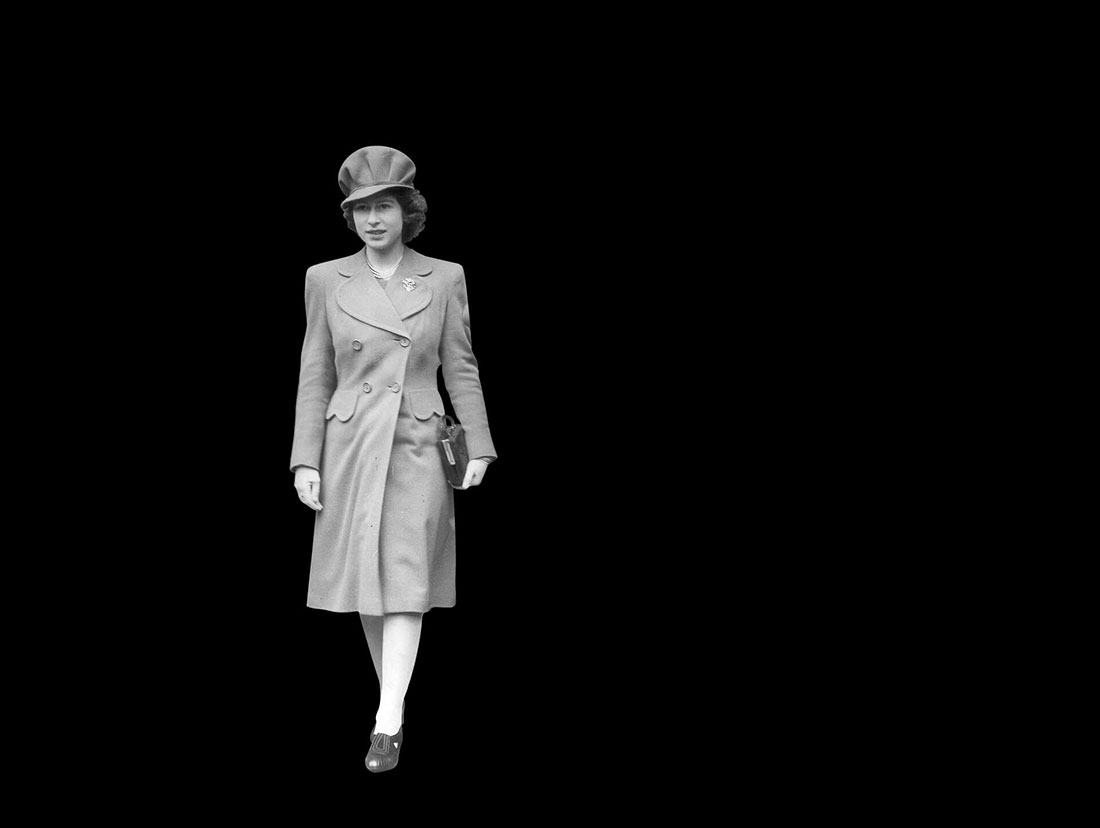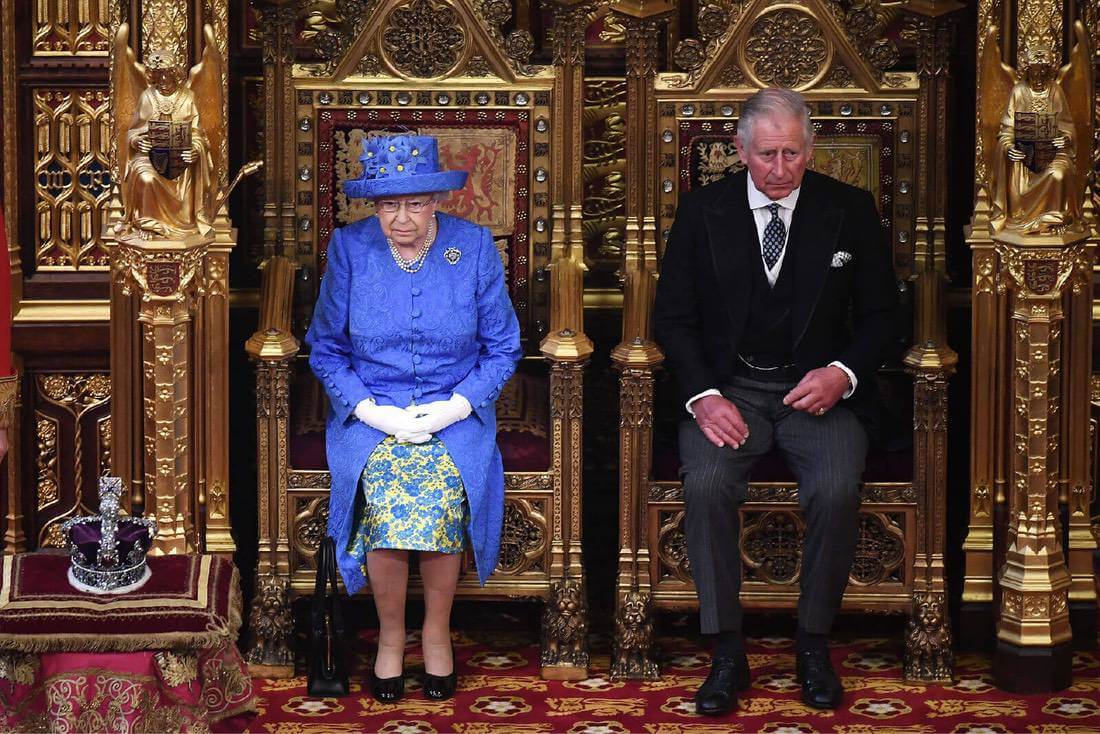It wasn’t often that you saw Queen Elizabeth with her hair uncovered. At state occasions, a crown or tiara rested atop a perfect coif. At the stables of Balmoral, where she tended to her ponies in Wellington boots and a Barbour jacket, a patterned scarf was always tied under her chin.
But most often, it was a hat.
“You almost can’t see it in isolation. There’s always a brooch, there’s usually pearls, there’s usually white gloves,” Beatrice Behlen, senior curator of fashion and decorative arts at the Museum of London, said in a 2019 phone interview. “And then the matching hat.”
Hats were a part of the Queen’s life from childhood, when she was photographed in bonnets and berets. She would continue to wear them through adolescence and young adulthood, often coordinating with younger sister Princess Margaret and the Queen Mother.


Baby in a bonnet
The Queen was well acquainted with impressive headgear even as a toddler. Here, around 1928, she wears a lace bonnet rippled with diaphanous ruffles.
Hulton-Deutsch Collection/Corbis/Getty Images/CNN Illustration
From the outset, her tastes were bold and provocative. Commissioning boundary-pushing milliners like Simone Mirman, Freddie Fox and, more recently, Rachel Trevor-Morgan, she embraced unconventional shapes, floral appliques, feathers and the full spectrum of colors.
As a princess and during the early days of her reign, Elizabeth was a trendsetter. In February 1944, when she wore “a creation based on an officer’s service cap” to the wedding of Lieutenant (later Captain) Christopher Wake-Walker and Lady Anne Spencer (Princess Diana’s aunt), the Associated Press reported that copies had been selling fast across London; and in 1946, the price of ostriches in South Africa is rumored to have skyrocketed after she and her mother wore ostrich feathers in their hats to London’s VE Day Parade.


A pair of peak-capped princesses
Leaving the wedding of Lady Anne Spencer and Lieutenant Christopher Wake-Walker in 1944, Elizabeth steps out beside Princess Margaret wearing a peak-cap hat and smart double-breasted coat.
ANL/Daily Mail/Shutterstock/CNN Illustration
When the Queen wasn’t setting trends, she was embracing them, following the vogue for small hats in the ‘50s and joining Barbra Streisand and Bianca Jagger in their embrace of the turban in the ‘70s.


Sunshine in Mexico
In 1975, during a visit to Mexico, the Queen shone in a sunny yellow polka dot turban and matching belted dress.
Serge Lemoine/Hulton Archive/Getty Images/CNN Illustration
“The Queen does not have to be ‘in fashion’; she IS fashion — and she has inspired her generation to return to elegance, to appreciate quality and to dress appropriately,” Dorothy Shaver, then president of the Lord & Taylor department store chain, declared to the Los Angeles Times in 1957, ahead of the Queen’s first state visit to America.
By the ’60s, hats were on the out, due to changing attitudes and trends. But the Queen was undeterred. “When she grew up, it was perfectly normal to wear hats so everyone, every woman, would have worn a hat,” Behlen explained. “It becomes a trademark when she continues to wear them when everyone else stops.”
As is always the case with women in politics, Elizabeth’s dress was dissected and scrutinized. She often seemed to use this to her advantage, deploying her accessories as vehicles for subtle messaging.
In 1946, she wore an oversized beret to meet a group of Girl Guides and a “cross between a pill box hat and a bedazzled ushanka” to Slovakia in 2008, wrote the artist and lecturer Oliver Watts in The Conversation. “Although ‘right’ for the occasion, this also has to be a kind of joke, a piece of humor to set people at ease with wit and generosity,” he added.


Visiting the terracotta army
Wearing a sky-blue pillbox hat and veil, the Queen inspects the 2,000-year-old terracotta army while visiting Xian, China in 1986.
Bregg/AP/CNN Illustration
We must assume a similar motive was behind her decision to wear a blue-and-yellow hat — matching the colors of the European Union flag — to open British parliament in 2017, just as Brexit negotiations were commencing. “Is the Queen wearing an EU hat?” wondered the BBC, and countless other speculators on social media. But of course, she never said.


Addressing a nation divided by Brexit
In 2017, during the opening of the House of Parliament, the Queen’s lapis blue hat caused a stir. Designed by royal dressmaker Angela Kelly and milliner Stella McLauren, it was quickly interpreted as an anti-Brexit symbol due to its uncanny similarity to the EU flag.
Carl Court/WPA Pool/Getty Images/CNN Illustration
The most enduring effect of her hat-wearing is perhaps the indelible mark it has left on Britain.
Over her 70-year reign, she helped cement the hat as a symbol of high-society sophistication, an attractive anachronism and a beacon of Britishness.
This is particularly remarkable considering that, across Europe, queens like Letizia of Spain and Máxima of the Netherlands now reserve hats for the most formal of occasions.


The Royal Airforce turns 100
At the Royal Airforce Centenary in 2018, the Queen stepped out in a blue and teal coat complete with matching hat embellished with a peacock feather, designed by Angela Kelly.
Chris Jackson/Getty Images/CNN Illustration
“Patronage of the royal family keeps hats alive. Her Majesty the Queen has kept hats alive in the imagination of people all over the world,” milliner Philip Treacy said on a 2018 episode of the BBC’s “Desert Island Discs” radio show.
“If the royal family chose not to wear hats — let’s say in the ’60s or ’70s when some people gave up on them — I wouldn’t really be sitting here having this conversation with you because hats are part of the culture of Englishness and of Britishness.”


Royal Ascot
The Queen brought an otherwise muted gray outfit to life with floral and feather detailing – on both her pleated hat and matching jacket.
Adrian Dennis/AFP/Getty Images/CNN Illustration
There are, however, occasions on the British calendar where wearing hats remains de rigueur — not least Royal Ascot, a horseracing event at which the Queen was once a guaranteed attendee. British bookmakers famously accepted bets on what color she would choose for the annual meet, with pinks and blues among her most frequently worn in recent years, according to betting firm William Hill.
Even she receded from public life, her mobility clearly declining, the Queen took every opportunity to be visible, often pairing brightly colored frock coats with matching hats so she was unmissable to her subjects.
One of Elizabeth II’s last public appearances, during her Platinum Jubilee celebrations in 2022, seemed to epitomize her approach. Bright green provided a moment of joy for the thousands of people gathered at Buckingham palace, yet it was tempered by a poignant act of tribute: a black pin attached to her hat in remembrance of husband Prince Philip, who had died a year before.


Platinum Jubilee
At her Platinum Jubilee celebrations, the Queen wore a black pin on a bright green hat in honor of her late husband Prince Philip.
Max Mumby/Indigo/Getty Images/CNN Illustration